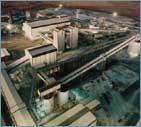Two companies that appear to have little in common have joined forces to
build processing plants that will convert biomass to energy and create organic
fertilizer at the same time. The plants will burn the waste to produce steam
that can power electric generators. The leftover residue can be sold as
fertilizer.
The partners are DukeSolutions, one of the fast States, and Harmony
Products, which specializes in the development and manufacture of fertilizer.
Their joint venture was planned to make productive use of the waste stream
from large Virginia poultry farms located in the Chesapeake watershed.
The plants will process 100,000 tons of litter annually, which will produce
enough energy to heat 15,000 homes. The resulting organic fertilizer will
increase crop yields, which will in turn feed the animals whose wastes are
then gasified to produce energyÃ?and of course more fertilizer.
Other advantages include reduced runoff into nearby lakes and streams from
the huge poultry producers. And, the gasification technology used to turn waste
into energy virtually eliminates emissions.
One processing plant is currently under construction in Harrisonburg, Va.,
and three others are in the planning stages. Eventually, DukeSolutions and
Harmony plan to run 200 processing plants worldwide. They are already working
on adaptations that will allow the plants to use other animal waste as well as
industrial wastewater sludge. These waste-to-energy systems will provide a
string of environmental benefits including clean, efficient energy, reduction
in agricultural runoff, and organic fertilizers.
Environmental News Service




